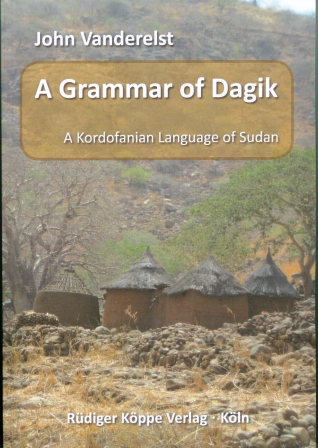
A Grammar of Dagik
A Kordofanian Language of Sudan
Author: John Vanderelst. Series edited by: Wilhelm J.G. Möhlig †, Bernd Heine.
Series: GA Grammatical Analyses of African Languages Volume 50
201620 pp. Roman, 263 pp.
3 colour maps, 1 figure, 34 tables, annexe: a proposal for an orthography, an interlinearized text: The Snake, Dagik-English wordlist
Text language(s): English
Format: 170 x 240 mm
680 g
Paperback
€ 69.80
Buy 'A Grammar of Dagik' as a downloadable PDF document directly from our online shop »
Order 'A Grammar of Dagik' as print edition »
The Dagik language is spoken in the Nuba Mountains in the Republic of the Sudan. It belongs to the Talodi subgroup of (what is known as) the Kordofanian language family.
Dagik speakers call themselves Duwa and their language Dhaduwa. To outsiders, they are also variously known as Nuba Dagik or Masakin. It is a small ethnic group consisting of 15,000 to 20,000 speakers. The Dagik home area consists of scattered villages in the Buram district, southeast of Kadugli, in the South Kordofan province. Large Dagik communities also live in Omdurman, Gedaref, and in South Sudan.
Prominent previous references to the Dagik in the literature, both linguistic and ethnographic, include Nadel (1947), Stevenson (1956-57), Riefenstahl (1974), and Schadeberg (1981). However, little was known about the language preceding this monograph.
This monograph is the first published complete grammar on a Talodi language. It is based on first-hand data collected by the author. The data corpus includes a word database, a sentence collection and a text collection. It is couched in a descriptive framework. It gives an overview of the language's structure from phonology (chapter 2) all the way through to clause structure. The nominal morphology is characterized by a rich nominal class and agreement system (chapter 3), the verbal morphology by many derivational suffixes (chapter 4).
Further prominent word classes such as adjectives, pronouns and indexes are described (chapter 5 and 6). Chapter 7 presents an in-depth analysis of the expression of space. The study of motion shows that one needs to distinguish between motion sensitive to the position of the deictic center, and motion sensitive to the position of the ground. Chapter 8 considers clause structure, both simple and complex, and closes with a look at information structure. A proposal for an orthography, an interlinearized text and a wordlist complete this description.
Under these links you will find descriptions of further Kordofanian languages and cultures, studies of deixis and space concepts, as well as reviews by Thilo C. Schadeberg and Nicolas Quint:
Accompanying material:
- A Grammar of Kordofanian Julut
(ISBN 978-3-89645-771-4 ) - Nayayirak tamaa dumurik – Speak Tima!
(ISBN 978-3-89645-413-3 ) - Nuba Mountain Language Studies
(ISBN 978-3-89645-427-0 ) - Nuba Mountain Language Studies – New Insights
(ISBN 978-3-89645-767-7 ) - The Nominal and Verbal Morphology of Tima
(ISBN 978-3-89645-559-8 ) - The Phonology of Koalib
(ISBN 978-3-89645-552-9 ) - The Tima of the Nuba Mountains (Sudan)
(ISBN 978-3-89645-898-8 ) - Tira and Otoro
(ISBN 978-3-89645-173-6 )
Cross-reference:
- Anthropologie des Raumes
(ISBN 978-3-89645-217-7 ) - Comparing African Spaces
(ISBN 978-3-89645-013-5 ) - Deictics, Copula, and Focus in the Ethiopian Convergence Area
(ISBN 978-3-89645-293-1 ) - Directionality in Grammar and Discourse
(ISBN 978-3-89645-899-5 ) - Mechthildian Approaches to Afrikanistik – Advances in Language Based Research on Africa
(ISBN 978-3-89645-226-9 ) - Motion in Datooga
(ISBN 978-3-89645-668-7 ) - Proceedings of the 2nd WOCAL World Congress of African Linguistics, Leipzig 1997
(ISBN 978-3-89645-124-8 ) - Räumliche Orientierung in nilotischen Sprachen
(ISBN 978-3-89645-661-8 )
Reviews
At first it seems that “A grammar of Dagik” is not difficult to read, but once you try to dig deeper, you realize how complex many issues are. Each subject is dealt with on just a few pages, not enough to answer all questions that come up. Looking at other recent studies of Kordofanian, notably on Lumun (TALODI; Smits 2017) but also on Moro (HEIBAN, e.g. Rose 2013), the lack of tonal data and analysis makes one suspect that many details of morphology and syntax remain undetected. “A grammar of Dagik” may have shortcomings in coverage and in analysis, but that is what one may expect from a pioneering work by a young scholar presenting an uncharted language from a very poorly known language group.
For some scholars, Kordofanian languages derive their interest primarily from their isolated position: they are the only real exclave of anotherwise contiguous large language family, i.e. Niger-Congo, and even within the assumed NC family tree they occupy a rather isolated position (or positions, see Dimmendaal 2014). “A grammar of Dagik” again shows that the study of any of these language substantially adds to our knowledge and understanding of African languages and of human language.
Thilo C. Schadeberg in Linguistique et Langues Africaines, 4/2018, 133-139
The various observations and restrictions developed above should not minimize the obvious merits and value of Vanderelst’s work, the first scholar to have successfully concluded a comprehensive description of a Talodian language. The fact that this Dagik grammar was recently followed by the description of another Talodian language (Smits 2017) shows that John Vanderelst’s painstaking work is not isolated, and that the field of Talodian (and Kordofanian) studies is growing steadily, thereby allowing the scientific community to get a more direct access to these hitherto under-researched languages.
Nicolas Quint in Journal of African Languages and Linguistics, 40/2, 2019, 311-316
PDF documents:
 | Review by Thilo C. Schadeberg | (≈ 142 kB) |
 | Review by Nicolas Quint | (≈ 2 MB) |
| « back | Print version | [top] |
 Books
Books Audio
Audio Biographies
Biographies Series
Series Festschrifts
Festschrifts Journals
Journals